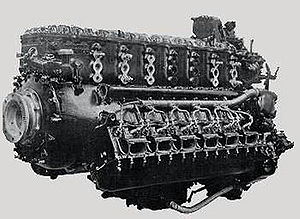Junkers Jumo 210
| Jumo 210 | |
|---|---|
 |
|
| Jumo 210 | |
| Type | Piston aero-engine |
| Manufacturer | Junkers |
| First run | 1932 |
| Major applications |
Messerschmitt Bf 109A-D Junkers Ju-87A |
The Jumo 210 was Junkers Motoren's first production inverted V12 gasoline aircraft engine, produced just before the start of World War II. Depending on version it produced between 610 and 730 PS and can be considered a counterpart of the Rolls-Royce Kestrel in many ways. Although originally intended to be used in almost all pre-war designs, rapid progress in aircraft design quickly relegated it to the small end of the power scale by the late 1930s'. Almost all aircraft designs switched to the much larger Daimler-Benz DB 600, so the 210 was produced only for a short time before Junkers responded with a larger engine of their own, the Junkers Jumo 211.
The first gasoline-burning aviation power plants that the Junkers Motorenwerke ever built, the L1 and L2 single overhead camshaft (SOHC) liquid-cooled inline-6 aviation engines of the early and mid-1920s. Development of this line lead up through the L8. All of these were developments of the BMW IIIa inline-6 SOHC German World War I aviation engine, which BMW allowed as they were no longer interested in development of their WW I designs. The Junkers L55 engine, however, was the very first V12 layout aviation powerplant of any type created by the Junkers firm, using a pair of the earlier straight-six L5 engines as a basis for an "upright" liquid-cooled V12 aviation engine, as the contemporary BMW VI engine already was.
Development of the Jumo 210 itself started in 1931 under the designation L10. The L10 was Germany's first truly modern engine design, featuring three valves per cylinder, an inverted-V layout, a supercharger as standard equipment, and a cast cylinder block. The 210 was odd in that the cylinders were machined into a block along with one side of the crankcase, two such parts being bolted together side-by-side to form the engine. Normal construction techniques used three parts, two cylinder blocks and a separate crankcase.
...
Wikipedia
